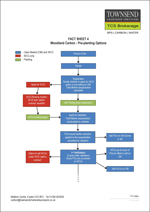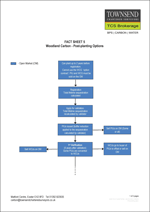
To download/view click here
1 Decided to plant?
First select the site. This is an important decision, as the land chosen affects the tree species that can be planted, how quickly they will grow, how expensive they will be to harvest and whether you will need to protect them from livestock, deer or squirrels, all of which can devastate a new planting. Planting can be hindered by landscape designations such as National Parks and Areas of Outstanding Natural Beauty. If a site is particularly ecologically valuable – for example, if it contains protected species such as dormice or great crested newts – this may change how the woodland must be designed, or even mean the site cannot be planted as woodland at all. For Woodland Carbon Code planting in particular, the site must also have no more than a 50cm peat layer in the soil, ideally less than 40cm.
The choice of site can also affect carbon sequestration potential not just through the choice of tree species, but also through soil type and previous land use. This is because some sites, particularly semi-natural sites on organic soils, already have significant carbon sequestered within them, so there is less to be gained environmentally from planting them as woodland, and correspondingly less payment for doing so. In addition, ground preparation and pest control all have a carbon cost as well as a financial one, so a site which requires high disturbance preparation work, such as ploughing above 30cm in depth, and large amounts of plastic tree guards and deer fencing will see a corresponding reduction in the carbon credits it earns.
The woodland could remain eligible for the BPS for up to 5 years after planting if
- the site was used to claim the Single Farm Payment in 2008; and
- planting is subsidised by a government scheme such as Countryside Stewardship or the Woodland Carbon Fund.
Former arable sites on mineral soils also receive a small uplift in carbon credits as the planting will improve soil carbon on these sites as well as sequestering from tree growth.
We can help with the selection of the right site for the planting objectives, which may also include sporting, IHT/CGT, carbon sequestration etc. and provide costings. We also offer a pre-purchase inspection service if a site has been found and it requires an assessment for woodland planting and carbon sequestration.
2 Design
The design of the woodland needs to be carried out – species of trees, how densely they will be stocked, how often thinning is planned, access routes, and systems to manage the land and extract further income. We will use decision support tools such as the Ecological Site Classification to carefully match tree species to site conditions including soil type, drainage, elevation, exposure and aspect. Other areas such as access for future management and the level of protection required during establishment will be considered and factored in.
Woodland design is a specialist area of work usually undertaken by a qualified professional. Our forestry team will help ensure the woodland is fully compliant as well as meeting all the objectives as effectively as possible, whether this is sequestering carbon, a commercial planting, amenity or sporting. Tree species selected will be required to meet minimum productive yield classes of 6 for broadleaves and 12 for conifers (10 for pine). Yield Class is a measure of growth and is expressed in cubic metres / ha / year.
Funding for establishment can be provided through The Woodland Carbon Fund, which supports the establishment of new productive multi-purpose woodland of 10ha or larger. This funding is at the same rate as the Countryside Stewardship Woodland Creation Grant (£6,800/ha) unless your site is close to an urban population and public access is provided within the design, in which case the grant increases to £8,500/ha. In either case, there will also be an additional payment of £1,000/ha at year 5 of the project.
There will be a requirement to carry out Stage 1 and Stage 2 scoping studies under the Town and Country Planning (Environmental Impact Assessment) Regulations 2017. These can be funded under the Woodland Creation Planning Grant which will pay £1,000 towards Stage 1 of the scoping study and £150/Ha (minus £1,000) for Stage 2. The scoping study will highlight considerations such as European Protected Species, semi-natural habitats and protected landscapes.
This design work will facilitate full accordance with the Woodland Carbon Code rules which at this stage require:
2.1 A management plan compliant with https://www.woodlandcarboncode.org.uk/standard-and-guidance/2-project-governance/2-2-management-plan
2.2 A design compliant with the UK Forestry standard, https://assets.publishing.service.gov.uk/government/uploads/system/uploads/attachment_data/file/687147/The_UK_Forestry_Standard.pdf. This will be handled by the forestry contractor
2.3 “Additionality” – creation of the woodland must not be required by law e.g. as a planning obligation or condition of a felling licence; have at least 15% of establishment and management costs to year 10 covered by carbon sales; and either not be the most profitable use for the land or else have overcome some barrier to establishment by joining the code, such as a lack of technical expertise or short-term capital.
2.4 A pre-planting consultation with stakeholders i.e. government bodies, EA etc.
2.5 Full legal compliance – the woodland must be ‘legal’ to plant. It should not, for example, be on a protected habitat site, obstruct a public right of way or destroy a badger sett.
Woodland design is a specialist area of work usually undertaken by a qualified professional. Our forestry team will help ensure the woodland is fully compliant as well as meeting all of the objectives as effectively as possible, whether this is sequestering carbon, a commercial planting, amenity or sporting.
Unless an application is being made to the Woodland Carbon Guarantee (WCG) scheme, planting can now begin.
3 Registration
Registration can occur up to two years after planting, unless an application is being made for the WCG, but this time is planned to be reduced to six months. As an IHS Markit registered Project Developer (PD), we can then register the woodland as a “project under development” with IHS Markit, the company responsible for cataloguing UK woodlands managed under the Woodland Carbon Code. To do this we will need:
3.1 Basic information about the planting (area, size, broadleaf/conifer, dates for start and end of planting, as well as an “end date” for when the woodland is not sequestering any more carbon).
3.2 The management plan from Stage 2.
3.3 An estimate of the woodland’s carbon sequestration, including the amount to be claimed under the code and a buffer, with a completed “carbon calculator” spreadsheet showing how this figure was reached.
3.4 A map of the planting, likely produced at Stage 2.
3.5 The choice of validator, either Soil Association or Organic Farmers and Growers.
When the registration is complete, the project will appear on IHS Markit. Woodlands can be registered in groups, which will reduce the administrative cost for each individual project throughout the scheme. These groups can either be of up to15 woodlands with no upper limit to total area, or of an unlimited number of woodlands provided none are more than 5ha in area and the total area of the group is less than 50 ha. The last planting in a group must take place no more than 5 years after the first.
4 WCG Scheme (optional)
After Registration (3), it is optional for an application to be made to the WCG scheme, which requires information already given when registering. If successful, an invitation will then be received for the next reverse auction. Auctions have been taking place approximately every six months. A bid can be made offering a price to the Government for the sale of future verified Woodland Carbon Units (WCU). If successful, a 30-35 year optional contract will be offered from the Government to buy WCU at the price bid. Money will be paid under the WCG scheme once carbon has actually been sequestered in at least five years’ time. The woodland cannot be planted until this auction has taken place and you have an ‘option contract’.
5 Validation for WCG and Open Market (OM)
The woodland can now be planted, if it has not been already. Validation must not take place more than three years after registration has been completed.
We will put together:
5.1 Documents proving the consultation took place at Stage 2
5.2 Documents related to the EIA, or proof one was not needed
5.3 The various basic information and Carbon Calculator required at Stage 3
5.4 Contact details for the person managing the woodland on the ground
5.5 An “additionality” spreadsheet demonstrating the woodland meets requirement 2.4
5.6 A “project design document”, which is essentially a 28-page application form
5.7 If the site has been inspected by the government, e.g. for a Countryside Stewardship Woodland Creation Grant, detail f this visit and the inspector’s findings
This will be sent to a validator, either the Soil Association or Organic Farmers and Growers, who will investigate in detail and may suggest improvements, which must be enacted within one month. They will also provide a more definite estimate of how much carbon the woodland will sequester than on the calculator. When validation is complete, the woodland will be issued with Pending Issue Units (PIUs) equal to 60% of this estimate, which can be sold. The validation process can take 4-6 months. The validator must visit the site if it has not been inspected as in 4.7, but otherwise they may choose not to. In addition to the charge for the validation, there is an additional one-off charge of 6p per PIU from IHS Markit.
6 Initial Verification
This occurs 5 years after planting was completed, but the validator should be contacted 12 months before this date. The following will be needed:
6.1 A monitoring report in a prescribed format showing stocking density, actual species mix, tree health, tree damage, weed growth and tree protection (shelters/fencing)
6.2 A progress report in a prescribed format, available at https://www.woodlandcarboncode.org.uk/landowners-apply/template-documents, showing action taken to meet the code rules so far.
The validator will then visit the site and suggest any corrective actions, which must be completed within one month. Once they receive proof corrective action has been taken, they will provide a Verification Statement document and convert an appropriate number of PIUs into WCUs. If the woodland was successfully entered into the WCG Scheme and placed a winning bid at the auction, these can then be sold to the government. Otherwise they can be sold to a private buyer or, if sold as PIUs, the buyer can now use them for marketing or compliance. This process usually takes 6-9 months.
7 Further Verifications
Every ten years after the initial verification, the PD must apply for a further verification resulting in further conversion of PIUs into WCUs. The same rules apply for this as for the initial verification, except that a site visit will not necessarily be needed.
This stage repeats every ten years until the agreed end date.
GLOSSARY
Broker: An organisation with an account on IHS Markit that allows them to buy Pending Issue Units and Woodland Carbon Units and sell them on to other businesses
Buyer: An organisation purchasing, or seeking to purchase Pending Issue Units or Woodland Carbon Units. They will either be a business seeking to use the credits themselves for marketing or to meet environmental commitments, or a broker
IHS Markit: Online platform on which woodlands which have undergone registration are displayed, and on which Pending Issue Units and Woodland Carbon Units associated with those woodlands may be bought and sold
Pending Issue Unit (PIU): An intangible asset representing one tonne carbon which a validator has predicted a woodland will sequester during its lifetime. When the woodlands successfully undergoes validation it will receive a number of these units on IHS Markit, which can then be sold. Note that businesses cannot use PIUs for marketing claims or environmental compliance. They must wait until the woodland is verified and the PIUs become Woodland Carbon Units before this can happen. PIUs are therefore, in theory, substantially less valuable than Woodland Carbon Units
Project: Internal Civil Service name for a woodland managed under the code, or seeking to be.
Project Developer (PD): An individual or organisation with an account on IHS Markit that allows them to arrange registration, validation and verification of woodlands for their clients, and also to sell their clients’ Pending Issue Units and Woodland Carbon Units
Project End Date: The agreed point at which the woodland has finished sequestering carbon, at which there will be no more Pending Issue Units for Verification
Project Start Date: The date at which planting is complete.
Registration: The process of getting a woodland to appear on IHS Markit
Sequester: The process of removing greenhouse gases from the atmosphere and storing them in a manner which prevents them from contributing to global warming
Validation: The process of a validator checking a woodland which has undergone registration is compliant with the Woodland Carbon Code . If successful, the woodland’s owner will be issued with a number of Pending Issue Units equivalent to the validator’s estimate of much carbon the woodland will sequester throughout its life
Validator: One of two organisations which can undertake validation and verification of woodlands, in exchange for a fee. These two organisations are the Soil Association and Organic Farmers and Growers
Verification: The process of a validator checking to see how much carbon a woodland which has undergone validation has managed to sequester, in exchange for a fee. On completion, this amount of the woodlands Pending Issue Units will turn into Woodland Carbon Units
Woodland Carbon Code: The scheme under which woodlands in the UK can undergo validation and verification so that the carbon they sequester can be sold on as Pending Issue Units and Woodland Carbon Units
Woodland Carbon Guarantee: Scheme in which the UK government contracts to purchase Woodland Carbon Units from a woodland at an agreed price whenever they successfully undergo verification. Sales are agreed at regular reverse auctions, and woodlands must not yet have been planted but must have undergone registration and completed an application form before they can participate.
Woodland Carbon Unit (WCU): An intangible asset which represents one tonne of carbon sequestered by a woodland which has undergone verification under the Woodland Carbon Code. It can be used by businesses for marketing or to meet internal targets or environmental standards such as ISO14001.
 |
 |
| Fact Sheet 4 – Woodland Carbon – Pre-planting options | Fact Sheet 5 – Woodland Carbon – Post-planting options |
